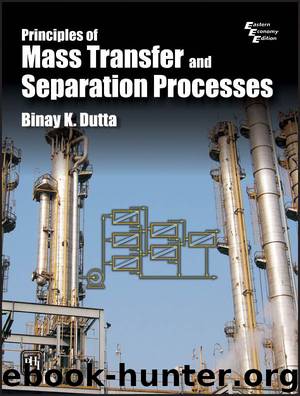Principles of Mass Transfer and Separation Processes by DUTTA BINAY K

Author:DUTTA, BINAY K. [DUTTA, BINAY K.]
Language: eng
Format: epub
Publisher: PHI Learning Private Limited
Published: 2013-06-26T00:00:00+00:00
Vi = Hm ND K FGr I12//13 L¥ -4 OP F 730 I12 Fd32 J13F I
F I
di i c J Gd32J= M()(.)(.)
s 0 0135 QH HI13
= 0 0631GD
L F I13d32 = 0.053(1 + 4.42Vi)0.6(We)–0.6 =(. )Di K
K
GDi KHrdK HDi 1030
K N Fd32 J
Hi K O(73850)–0.6
D
i
M
1+ ( . )(.0 0631)Gd32 J
H P
N Q
d32 = 6.5 ¥ 10–5fiDi
fi d32 = 7.15 ¥ 10–5 m = 0.0715 mm
The second correlation gives a much smaller value of the Sauter mean drop diameter.
6j = ()( .0 1616) = 194 ¥103 23fi Interfacial area of contact: a = d32 510-4 m/m Correlations for mass transfer coefficients
The dispersed phase mass transfer coefficient can be approximately calculated from the following relation (Treybal, 1963) assuming the drops to be rigid. A drop can generally be considered ‘rigid’ if it is smaller than about 1mm and the interfacial tension is more than 15 dyne/cm.
(Sh
d) =
kd
d 32 = 6.6 (8.26)Dd where (Shd) is the dispersed phase Sherwood number, kd is the dispersed phase mass transfer coefficient, and Dd is the diffusivity of the solute in the dispersed liquid. More correlations for the dispersed phase mass transfer coefficient in an agitated liquid–liquid dispersion have been suggested by Skelland and Xien (1990).
The continuous phase mass transfer coefficient can be calculated from the Skelland and Moeti (1990) correlation.
Download
This site does not store any files on its server. We only index and link to content provided by other sites. Please contact the content providers to delete copyright contents if any and email us, we'll remove relevant links or contents immediately.
| Automotive | Engineering |
| Transportation |
Whiskies Galore by Ian Buxton(41937)
Introduction to Aircraft Design (Cambridge Aerospace Series) by John P. Fielding(33091)
Small Unmanned Fixed-wing Aircraft Design by Andrew J. Keane Andras Sobester James P. Scanlan & András Sóbester & James P. Scanlan(32763)
Craft Beer for the Homebrewer by Michael Agnew(18194)
Turbulence by E. J. Noyes(7977)
The Complete Stick Figure Physics Tutorials by Allen Sarah(7336)
Kaplan MCAT General Chemistry Review by Kaplan(6899)
The Thirst by Nesbo Jo(6877)
Bad Blood by John Carreyrou(6581)
Modelling of Convective Heat and Mass Transfer in Rotating Flows by Igor V. Shevchuk(6406)
Learning SQL by Alan Beaulieu(6237)
Weapons of Math Destruction by Cathy O'Neil(6213)
Man-made Catastrophes and Risk Information Concealment by Dmitry Chernov & Didier Sornette(5951)
Digital Minimalism by Cal Newport;(5700)
Life 3.0: Being Human in the Age of Artificial Intelligence by Tegmark Max(5509)
iGen by Jean M. Twenge(5384)
Secrets of Antigravity Propulsion: Tesla, UFOs, and Classified Aerospace Technology by Ph.D. Paul A. Laviolette(5332)
Design of Trajectory Optimization Approach for Space Maneuver Vehicle Skip Entry Problems by Runqi Chai & Al Savvaris & Antonios Tsourdos & Senchun Chai(5037)
Pale Blue Dot by Carl Sagan(4950)
